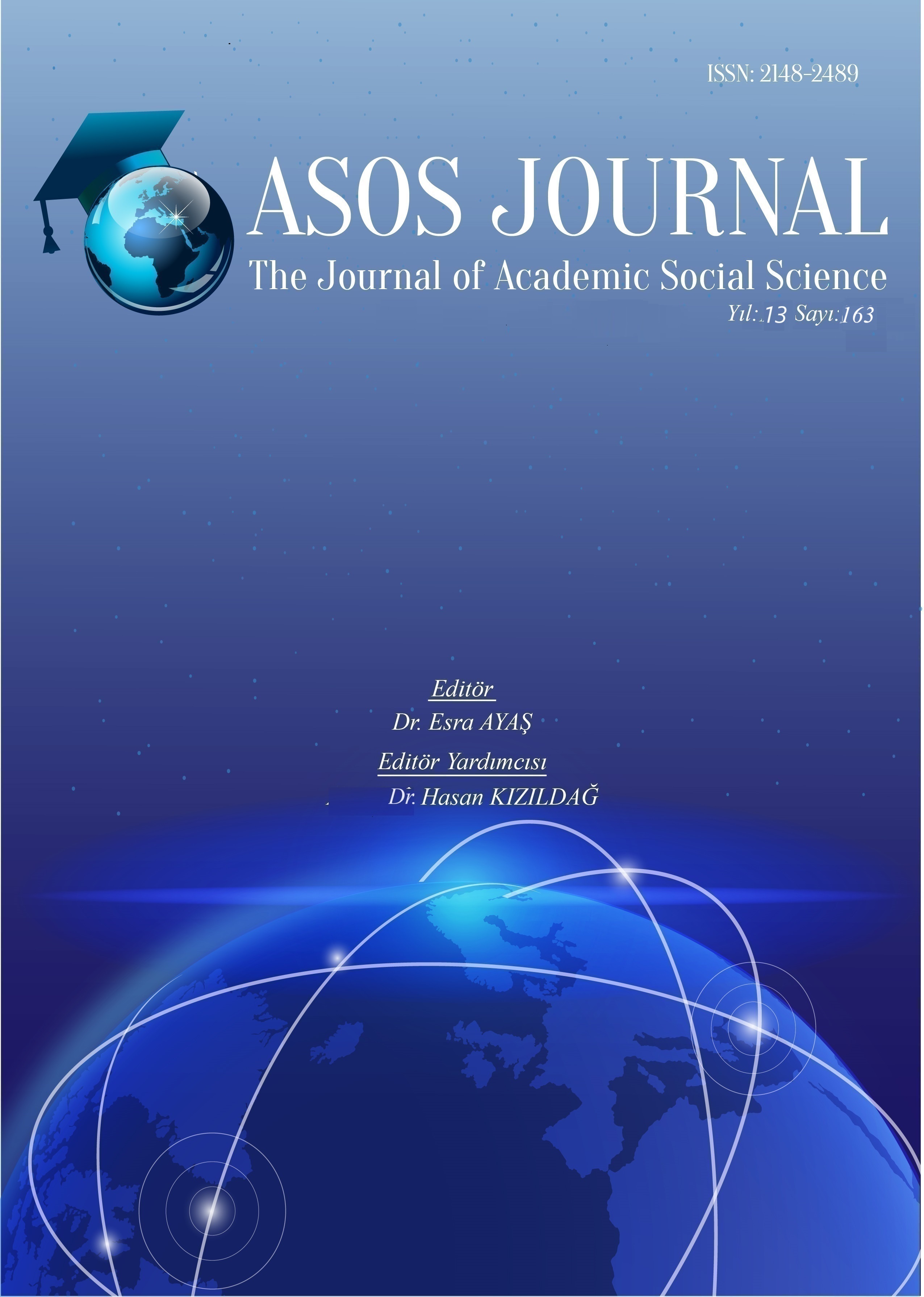Author :
Abstract
Çağdaş sanatta soyutlaşma sürecini meydana getiren sosyokültürel unsurlar, soyutun oluşum biçimini “görsel” bir algılamaya dönüştürdüğü kadar, aynı zaman- da “kavramsal” bir algılama biçimine de dönüştürür. Bu ilişkilenme yapısıy- la; soyutun görsel biçimi ile kavramsal içeriği arasında bilgibilimsel bir iletişim kurulur. Soyutlaşmanın oluşumunu sağlayan görsel olasılıkların karşılığı olabilecek düşüncelerin, dil ve anlam açısından yeterli seviyelerde kurgulanabilmesi; “görsel” ile “düşünsel” olgular arasındaki sorunun temel çözüm alanını ortaya koymakla birlikte, problemin ilişkilenme biçimi de bu zemin üzerinde çözülmeye çalışılır. Soyutlaşma olasılıklarını temsil eden tüm görsel biçimlendirmelerin, düşünme olasılıklarını temsil eden bütün kavramsal anlamlandırmalarla ilişki kurma biçim- leri, bu makalenin temel konusunu oluşturmaktadır. Buradan hareketle, soyut sanatın “kavramsal biçimlenmeyi” görsel alanda algıbilimsel bakımdan oluşturma yöntemleri ile, Gestalt teorisi arasındaki zihinsel ilişkilerin asıl olarak ne olduğu, nasıl kurulduğu ve ne tür bağlantılar yarattığı makalenin nihai amacını ortaya koymaktadır. Gestalt teorisiyle, sanatta soyutlaşma eğilimleri arasındaki benzer- liklerin, kimi zaman her iki unsurun da “neredeyse birbirlerinin yerine geçmelerini sağlayacak kadar yakınlaşan “ilkesel unsurlara” dayanmaları; soyut sanat teorisinin daha derin düşünceler üretebilmesi açısından özel bir önem oluşturmaktadır. Bu kapsamda, Gestalt teorisinin soyut sanatın ontolojik yapısı içerisinde kavramsal soyutlaşmayla kurduğu ilişkiler ve bunu destekleme gerekçeleri, literatür açısından her iki unsurun da özel olarak araştırılıp, birbirleriyle ilişki kurdukları ortak payda alanlarının karşılaştırılarak açıklanmasını gerektirmektedir. Bu kapsamda, sanatta soyutlaşma olgusunu yaratan nedenler, Gestalt teorisine göre; insanın beyin yapı- sıyla birlikte psikolojik yapısının neden olduğu davranış biçimleriyle aynı anda ele alınarak, bu ilişkide daha fazla ortak noktanın bir araya gelebileceği sanatsal ve bilimsel açılardan ifade edilmelidir. Zira Gestalt teorisi, psikoloji biliminin deney- sel verilerinden hareket ettiği kadar, sanatsal yaratıcılığın felsefi boyutlara dayanan düşünselliğinden de mutlak suretle hareket etmektedir. Dolayısıyla, makalenin sonucu açısından değerlendirildiğinde, burada ifade edilen tüm unsur- ların, çağdaş soyut sanat eserlerindeki biçimlenme olgusunun Gestalt teorisiyle birlikte “karşı-laştırmalı olarak” ele alınması; “yaratıcılığı temel alan içerik ve biçim ilişkileri kapsamında” her iki alanın kendi içindeki etkileşimlerin yoğunlaşmasına çok daha güçlü katkılar sağlamaktadır.
Keywords
Abstract
The sociocultural elements that bring about the process of abstraction in contem- porary art transform the formation of the abstract into a ‘visual’ perception as well as a ‘conceptual’ perception. With this relation structure, an epistemological com- munication is established between the visual form of the abstract and its conceptual content. The ability to construct the thoughts that can correspond to the visual possibilities that enable the formation of abstraction at adequate levels in terms of language and meaning reveals the basic solution area of the problem between ‘visual’ and ‘intellectual’ phenomena, and the way the problem is related is tried to be solved on this ground. The ways in which all visual formalisations representing the possibilities of abstraction relate to all conceptual significations representing the possibilities of thinking constitute the main subject of this article. From this point of view, the ultimate aim of the article is to reveal what the cognitive rela- tions between the methods of abstract art's ‘conceptual formation’ in the visual field in terms of perceptual science and Gestalt theory are, how they are established and what kind of connections they create. The fact that the similarities between Gestalt theory and the tendencies towards abstraction in art are based on ‘prin- cipled elements’ that sometimes become so close that both elements are ‘almost interchangeable’ is of particular importance for the theory of abstract art to produce deeper thoughts. In this context, the relations that Gestalt theory estab- lishes with conceptual abstraction within the ontological structure of abstract art and the reasons for supporting it require both elements to be specifically researched in terms of literature and explained by comparing the common denominator areas in which they relate to each other. In this context, the reasons that create the pheno- menon of abstraction in art, according to the Gestalt theory, should be handled at the same time with the behaviour patterns caused by the brain structure and psychological structure of the human being, and it should be expressed from artistic and scientific perspectives that more common points can come together in this relationship. Because Gestalt theory, as much as it moves from the experi- mental data of psychological science, it also moves from the intellectuality of artistic creativity based on philosophical dimensions. Therefore, when evaluated in terms of the conclusion of the article, the ‘comparative’ consideration of all the elements expressed herein, together with the Gestalt theory of the phenomenon of shaping in contemporary abstract artworks, provides much stronger contributions to the intensification of the interactions within both fields ‘within the scope of content and form relations based on creativity’.





